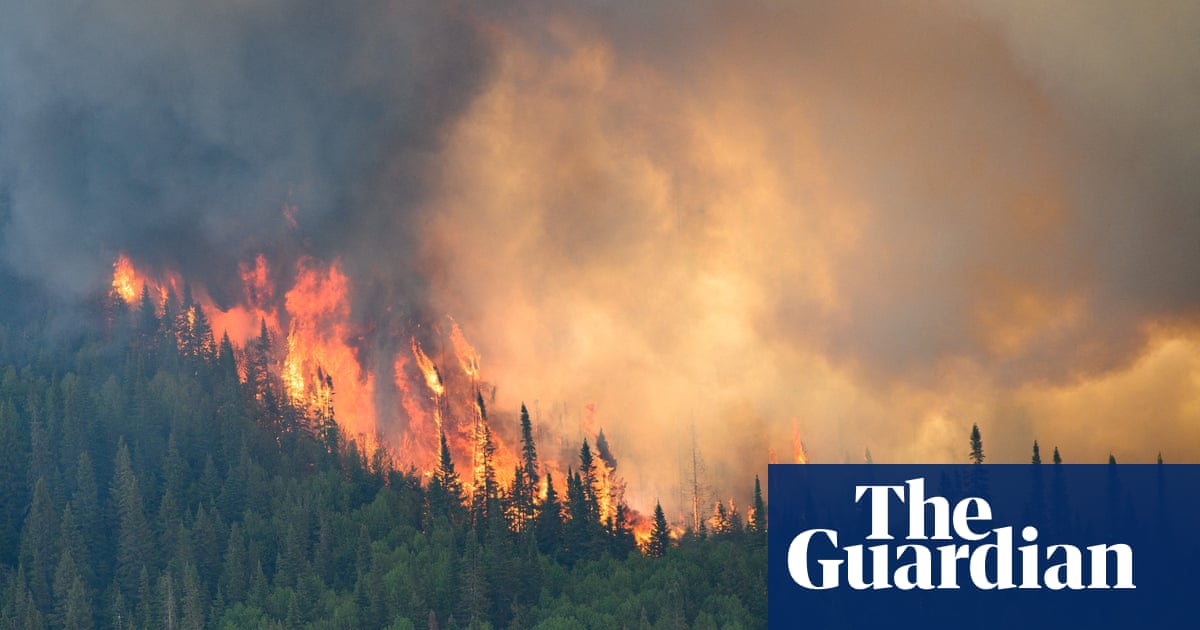
The vast swaths of pine, spruce and larch forest that blanket much of Canada have been prized for generations. Not only do they provide a home to hundreds of species – including some of the most threatened in the country – but they also absorb more greenhouse gases than they emit, acting as a huge carbon sink.
This summer, however, as flames devoured one of the largest contiguous stretches of woodland on the planet, 2bn tonnes (2.2bn tons) of carbon dioxide were released into the atmosphere.
Emissions from Canada’s record-breaking wildfire season are probably triple the country’s annual carbon footprint, experts warn, as climate systems reach a “tipping point”. The trajectory of the country’s wildfires has raised questions about how Canada can better tackle the blazes – and whether the issue is a global problem as nations race to reduce the volume of greenhouse gases emitted into the atmosphere.
Werner Kurz, a recently retired scientist with Natural Resources Canada, estimates nearly 2bn tonnes of carbon have already been released into the atmosphere from the record-breaking wildfire season, which federal officials warn could persist into the winter.
“It’s definitely off the scale,” said Kurz, a key figure in developing tools to measure the “carbon budget” of the country’s forests.
The figure far exceeds all of the emissions tied to Canada’s economy each year, which emit a total of 670m tonnes. Even emissions from burning in the managed forests, which refers to any part of the country’s hinterland that is logged or stewarded through the park system, has exceeded the total of Canada’s economy, with an estimated 850m tonnes emitted.
Kurz cautions the figures for both the managed forests and the national aggregate are preliminary, given the uncertainty of identifying the precise scope of the area burned as fires still rage across the country.
On Wednesday, the prime minister, Justin Trudeau, used the wildfires to promote his country’s carbon tax at a United Nations event in New York.
“First responders on the frontlines understand that ambitious collective action to tackle climate change is now a matter of survival,” he said.
But when the final tally is measured in the coming years, the emissions from wildfires will not be counted against Canada’s Paris agreement commitments, a reality that has long frustrated climate scientists, who fear far more carbon is released into the atmosphere than people realize.
In 2018, the governing Liberal party pledged to plant 2bn trees within the decade – a goal it looks unlikely to fulfil. At the time, the federal government touted the aim as a way of eliminating 2m tonnes of greenhouse-gas emissions annually – a figure now dwarfed by this year’s wildfire emissions.
The way in which forests, long prized for the way they actively remove carbon dioxide from the atmosphere, have easily eclipsed all combined emissions from Canada, has rewritten a longstanding narrative of the sprawling boreal landscape.
During the 1990s, Canada’s managed forest removed an average of 160m tonnes from the atmosphere.
But decades of large wildfire and the mass die-off of trees from insects transformed the boreal from carbon sink to source.
Western regions of the boreal have already seen bogs and wetlands dry up, parching typically damp areas of the forest. With drier, warmer conditions already a catalyst for bigger, hotter fires, experts warn ecosystems are entering a positive feedback loop, where fires beget even larger fires.
“It is really important that we all understand just how ecology has reached a tipping point. The impacts of climate change have effectively taken the reins out of our hands. That’s a really big concern,” said Kurz, adding that there were similar concerns with the rapid thawing of permafrost.
This summer has been exceptionally bad for Canada’s wildfires: 6,369 wildfires have scorched nearly 18m hectares of woodland, far in excess of historical norms. More than 200,000 residents have been forced to flee their homes.
The size of the fires has also troubled experts: two of the fires have exceeded 1m hectares and the vast majority of land burned across the country is attributable to only a handful of fires – all of which Kurz calls “indefensible” blazes, because of their ferocity, speed and heat.
The West Kelowna fire chief, Jason Brolund, recently said the fires that tore through the region had a “scope and scale it’s nearly impossible for us to be successful against”.
The immense blazes that roared through much of the country are, in part, due to a legacy of poor forest management. The logging industry has long prized conifers and has gradually reshaped the landscape with lucrative – but highly combustible – trees. Decades of fire suppression, as well as a shift away from prescribed burns practiced by Indigenous communities, has left much of the forest floor littered with flammable deadfall.
“We now see that all this stored carbon and all this stored potential energy that is associated with these forests and the fire conditions that are created by the changing climate can no longer be defended against,” said Kurz.
As for the northern parts of the country that haven’t been logged or managed, including the Northwest Territories that saw unprecedented blazes: “It’s literally just climate change,” he said.
He also warned that over the next few decades, even more carbon will be released as the trees killed by fire decompose. “Direct emissions are really only part of the story when it comes to long-term carbon emissions,” he said.
Canada’s largest fires are impossible to fight: they burn too large and too hot. Even so, in early September, Canada’s federal government announced hundreds of millions of dollars to purchase more firefighting tools, including pumps, hoses, chainsaws, cameras and drones, as well as a wildfire satellite monitoring system.
But experts have also long called for changes to the way the provinces and municipalities manage the forests, including the need to have more broken-up landscapes, more prescribed burns and a significant shift to the species that make up the forest canopy in order to replace combustible conifers with more fire-resistant broadleaf species.
A summer of heavy smoke blanketing major cities along eastern North America, with much of the smoke originating in Canada, has prompted broader discussions about the interconnected nature of natural events – and where blame lies.
“People say ‘Canada should be reporting all these wildfire emissions and take responsibility for them.’ Others point out this is a global climate change problem and Canada is a small fraction of the global population,” said Kurz.
“In Canada’s case, we’ve emitted three times the emissions of all of the sectors [of the economy] combined. We could shut down our economy to zero emissions, and we would still have all these wildfire emissions. When we look at the massive question of climate change and the impact of these wildfires – are they really just a national responsibility? This is something that we as a global community need to ask ourselves.”











